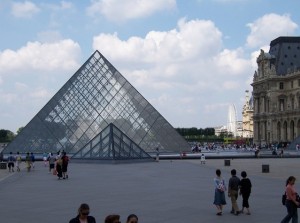Iconic Glass Structures: Louvre Pyramid in Paris
If you’re planning to go to Paris before June 27, you should know that you won’t be able to see the iconic glass pyramid structure outside the world-famous Louvre Museum. While the museum is temporarily closed due to flooding, and art lovers fear for the safety of the Louvre’s priceless collection, the Glass Pyramid in front of the building is doing just fine. You just can’t see it.
The Museum invited Paris street artist JR to wrap the Glass Pyramid in the medium of his choice. JR took life-sized photograph of the Louvre, in black and white, and applied them to the front facing panel of the Glass Pyramid. With JR’s help, look directly at the Glass Pyramid and all you’ll see is the Louvre as it looked before the Pyramid’s arrival in 1984.
Glass Pyramid was designed by I.M. Pei
The Louvre Pyramid was commissioned in 1984 by then-President Francois Mitterrand, and was designed by world-renowned architect I.M. Pei. I.M. Pei is known for his architectural designs; he also designed the Kennedy Library in Boston, the Dallas City Hall, the Hancock Tower in Boston and the National Gallery East in Washington, D.C. The Glass Pyramid was created to address traffic flow problems at the Museum’s entrance, and sits on top of a welcoming lobby. The Glass Pyramid is the first structure to greet nearly 5 million visitors from around the world annually. The lobby underneath the Glass Pyramid is being renovated, in order to accommodate a growing number of visitors.
The Louvre itself started out as a medieval fortress, built in the 1200’s. In the 1400’s, it was converted to a royal palace, and in the mid-1500s, most of the original portion of the building was razed and rebuilt. The Glass Pyramid sits in front of the Cour Carrre, the oldest portion of the Museum, and the portion of the building that was replaced in the mid-1500s.
The number of glass panes is controversial. When the Glass Pyramid first opened, official Museum literature and news reports of the time said the piece had 666 panes of glass, a figure that was worked into Dan Brown’s fictional work The Da Vinci Code. The Museum later corrected the figure to 672. According to the designer, the Glass Pyramid has 689 glass panels that are shaped either like a rhombus or a triangle.
The number of panes of glass in the Glass Pyramid is far from the only controversy the structure has created. More than 30 years after its construction, the Glass Pyramid still invites passionate discussions about the combination of modern glass construction against a French Renaissance background, the cultural differences of modern France, the symbolism of a pyramid and of course, it’s cost to build (about USD$16M).
If you’d like to decorate glass, you don’t need to hire a Parisian street artist. Glassprimer™ glass paint can do the trick! If you’d like some inspiring ideas about decorating glass, please check out the rest of our site. If you’d like to purchase Glassprimer™ glass paint, please visit our online store .
Photo Credit: Colin Cushman , via FreeImages.com

